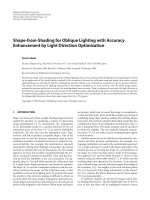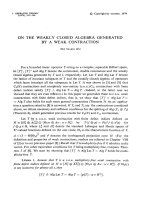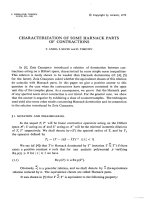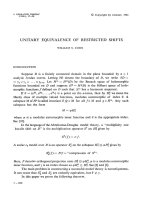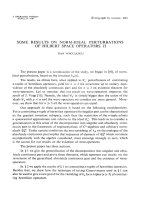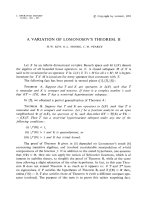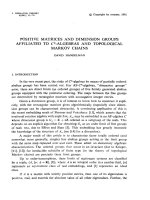Báo cáo toán học: "Shape Tiling" pdf
Bạn đang xem bản rút gọn của tài liệu. Xem và tải ngay bản đầy đủ của tài liệu tại đây (182.1 KB, 5 trang )
Shape Tiling
Kevin Keating & Jonathan L. King
&
University of Florida, Gainesville FL 32611-2082, USA
Submitted: 28 July 1996 Accepted: 21 November 1996
Given a list 1×1, 1×a, 1×b, ,1×c of rectangles, with a,b, ,c non-negative,
when can 1 × t be tiled by positive and negative copies of rectangles which are similar
(uniform scaling) to those in the list? We prove that such a tiling exists iff t is in the
field (a,b, ,c).
When can rectangle 1 × t be packed by (finitely many) squares? Dehn 1903 gave
the answer: If and only if t is rational. For irrational t he showed 1 × t not packable
bymeansofwhatwewillcalla“Dehn-functional”.ItisamapDfrom pairs of real
numbers to (or any abelian group) which satisfies:
D
[x + x
] × y
= D(x × y)+D(x
×y)
D
x×[y+y
]
= D(x×y)+D(x×y
)
It is straightforward to check that for a packing of a rectangle c × d by finitely-many
others, D(c × d) must equal the sum of the functional applied to each rectangle in the
packing. (The analogous statement applies to tiling. See the Definitions section, below, for a formal
definition of packing and tiling.)
Two recent papers by Freiling & Rinne 1994, and by Laczkovich & Szekeres
1995, turn the question around: For which sidelengths, s, can the square be packed by
rectangles similar to 1 × s and s × 1? Employing a Dehn-functional and a theorem
of Wall 1945, they give this astonishing answer: Iff s is algebraic over ,andallofits
conjugates in the complex plane have positive real part. (We shall henceforth refer to
such numbers s as Wall numbers.)
Tilings. Every packing problem has an analogous problem using both positive and
negative copies of the prototiles; we will call this operation “signed packing” or “tiling”.
It turns out that Dehn’s question has the same answer if tiling is allowed: 1 × t can
be tiled by squares iff it can be packed by squares. However, one sees readily that the
[FR,LS] question has a larger answer if tiling is allowed, by considering the Golden Ratio
1991 Mathematics Subject Classification. 05B45. Secondary: 52C20 51M25 05B50 12E99.
Key words and phrases. Tiling,packing,Wallnumber,Dehn’stheorem,fields.
2
λ :=
1+
√
5
2
. The conjugate of the Golden Ratio is
1−
√
5
2
, which is negative. Thus the
[FR,LS] theorem guarantees that no square can be packed by rectangles similar to
1×λ and λ×1. Nonetheless, there is a tiling:
1
λ
2
λ = λ − 1
λ
2
The dark rectangle, λ×1, is be-
ing subtracted from the top of the tall
λ × λ
2
rectangle. Since λ
2
equals λ+1,
what remains after the subtraction is
the λ × λ square.
The goal of our article is to establish a general tiling theorem for rectangles. A special
case of the Tiling Theorem, below, is:
Rectangles with shapes
1 × s, s × 1
can tile a square IFF s ∈ (s
2
).
Definitions. As usual, let (x) denote the field of rational functions of x,withcoeffi-
cients in .Forζa complex number, (ζ) is the smallest subfield of containing ζ.
Given a (finite or infinite) subset S ⊂ ,let (S) be the smallest subfield of which
includes S.
Identify a rectangle a×b with a product of half-open intervals, the subset [0,a)×[0,b)
of the plane. A translate, T ,ofa×bis a set of the form
[t
1
,t
1
+a) × [t
2
,t
2
+b)
where t
1
,t
2
∈ . Say that a collection of rectangles packs c × d if we can find a
(finite) collection, TRANS, of translates of copies of rectangles in such that we have
equality
1
c×d
=
T ∈TRANS
1
T
between indicator functions. (Indicator function 1
T
is 1 for each point (x, y)inT and is 0 for all
other points in the plane.)
Say that collection tiles (or “signed-packs”)rectangleB = b
1
×b
2
if: A finite
collection TRANS and coefficients α
T
∈{1,−1}can be found so that
1
B
=
T ∈TRANS
α
T
1
T
. (2)
(All of these definitions make sense in D-dimensional Euclidean space. For integer-sided D-dimensional
polyominoes and bricks, this type of tiling question was studied by [B1,B2] and [Kin].
In particular, given a finite proto-set of D-dimensional bricks there is an algorithm –which runs, as
a function of the number of bits needed to describe a brick B = b
1
×b
2
×···×b
D
, in linear time– to
determine whether B is tilable by . There is also a computable number M = M( )sothatifeach
sidelength b
i
≥M,thenBis -packable iff it is -tilable.)
3
Lastly, a tiling 1
c×d
=
T ∈TRANS
α
T
1
T
is “horizontally splittable” if we can write
c = c
(1)
+ c
(2)
and TRANS = C
(1)
C
(2)
, a disjoint union of non-empty sets, so that:
1
c
(i)
×d
=
T ∈C
(i)
α
T
1
T
,
for i =1,2. Define “vertically splittable” analogously.
Tiling (2) is completely-splittable if, either: TRANS is a singleton or –recursively–
the tiling can be split, either horizontally or vertically, into two tilings each of which is
completely-splittable.
Shapes. Uniformly scaling rectangle a×b by scale-factor u (a positive number) yields
rectangle au × bu.Lettheshape a × b represent the set of all uniform-scalings of the
rectangle. Consequently, say that shape-packs c × d if the union
a×b∈
au × bu
u>0
packs c × d.
Define “ shape-tiles c × d” analogously.
§2 Some Results
We start with a normalization. For each positive number v, a collection
1 × s
s∈S
shape-tiles 1 × t iff
1 × vs
s∈S
shape-tiles 1 × vt.Wecanchoosevso that some
product vs is 1. Consequently, we can assume, gratis, that S contains 1.
Tiling Theorem, 3.
Suppose 1 ∈ S,whereSis a (finite or infinite) set of positive
reals. Then rectangles :=
1 × s
s ∈ S
shape-tile 1 × t IFF t is in (S),andt≥0.
Moreover, when t ∈ (S), there is a tiling which is completely-splittable and uses
only scale-factors in the field (S).
Proof.
For a tilable 1 × t, it will be temporarily convenient to say that 1 × (−t)is
tilable also. Definition (2) extends consistently to rectangles with negative sidelengths,
if we identify 1
a×(−b)
and 1
(−a)×b
with −1
a×b
.Thuswecanfreelyremovethe“t≥0”
in the statement of the theorem.
We will make use of the field K := ( S ).
Establishing (⇒). If t/∈Kthen there exists
†
a K-linear functional f : → such
that f(t)=0andf(1) = 1. Thus
D(x × y):=x·f(y)
is a Dehn-functional. For any s ∈ S and real u,
D(u × su)=u·f(su)=u·s·f(u)=D(su × u) .
†
We can define the linear functional by picking a K-basis for .Or,wecanavoidtheAx-
iom of Choice, as follows. Let V be the K-vector-subspace of spanned by the sidelengths of all
the rectangles in the purported tiling. Extend the collection {t, 1} to a K-basis for V ,thendefinefon
this basis to get the desired K-linear-functional f : V → .
4
Thus the Dehn-functional D(y ×x) −D(x×y) is zero on every shape in the proto-set .
Hence this Dehn-functional must be zero on each tilable rectangle. On the other hand,
its value on 1 × t is the difference t · 1 − 1 · 0, which is not zero.
Establishing (⇐). Let G,the“good set”, be the collection of numbers t such that
1 × t is shape-tilable by the proto-set. Consider good numbers p and q.Then1×(−p)
is tilable and, by stacking 1 × p on top of 1 × q,also1×(p+q) is tilable. Thus
The good set is preserved under negation and addition.
What happens when we place 1×p and 1×q side-by-side? Scaling each appropriately
gives rectangles q × qp and p × pq. These tile (p + q) × pq.Soifp+q= 0, we conclude
that
pq
p+q
is good. Thus
The good set is preserved under “twisting”
where, for p = −q,wedefinethetwist of p with q to be
pq :=
pq
p + q
.
Notice that the operation of twisting rectangles 1 × p and 1 × q scales them by scale-
factors
q
p+q
and
p
p+q
, both of which are in K.
Lastly, since the operation of twisting (resp. addition) corresponds to building a tiling
which splits horizontally (resp. vertically), the following Field Lemma will complete the
proofofthetheorem. ♠
Field Lemma, 4. Suppose 1 ∈G,whereGis a subset of which is closed under
negation, addition and twisting. Then G is a subfield of .
Proof. Suppose p is “good”,thatis,inG.Thenpn and p/n are good, for positive
integers n; this follows by induction and using that goodness is preserved under addition
andtwist.Inthefollowing,pand q are assumed to be good.
Reciprocals are good: For p =0,notethat(p−1) 1=
p−1
p
is good. Thus
1
p
,
which equals 1 −
p−1
p
,isgood.
Squares are good: Since (1 ± p)isgood,(1−p) (1 + p) is good. Multiplying
by −2 yields that p
2
− 1 is good, hence p
2
.
Products are good: Since (p + q)
2
− (p − q)
2
is good, so is 4pq and thus pq. ♠
Addendum. Note that the lemma continues to hold with replaced by any field whose
characteristic is not two, i.e, 1 + 1 =0.
Question. By using a Dehn-functional, it is straightforward to see that if the tiling
in Theorem 3 is actually a packing, then all the scale-factors must be in (S).
Does this same conclusion hold for all minimum-cardinality tilings? (I.e, those which
minimize the cardinality of TRANS, the set of translates).
5
Closing remark. The [FR,LS] theorem suggests studying the following transitive re-
lation on the positive reals: s t if
1×s, s×1
shape-packs 1×t. Restating their
result: s 1iffsis a Wall number. Consequently, these numbers are hereditary; if
s t,withtaWallnumber,thensis too.
We currently have no understanding of the arrow relationship. Certainly if the min-
imal polynomial of s is unrelated to that of t, then there is no reason to expect s t.
Our theorem can, of course, give no positive result. It does, however, give the negative
result that even if s and t have the same minimal polynomial, neither need arrow the
other—simply because neither tiles the other.
In the normalization of the Tiling Theorem, a collection
1×s, s×1
shape-tiles 1×t
exactly when st ∈ (s
2
). Now suppose lengths s and t have a common minimal polyno-
mial f(x) ∈ [x] which is cubic with three positive roots. Certainly st /∈ (s
2
) occurs
if (s) fails to contain all three roots. And this will be the case if the discriminant of f
is not a perfect square. (See definition and corollary of [Jac, p. 258].) Indeed, we only need
findsuchanfwith 3 real roots since, for a sufficiently large integer T , the translated
polynomial x → f(x − T ) will have all roots positive.
An example is provided by f(x):=x
3
−6x+ 2, which has 3 real roots and, by
the Eisenstein Criterion [H, Thm. 3.10.2], is irreducible. The discriminant of f equals
−4 · (−6)
3
− 27 · 2
2
=6
2
·3·7, which is not a perfect square.
References
[B1] F.W. Barnes, Algebraic theory of brick packing, I, Discrete Math. 42 (1982), 7–26.
[B2] F.W. Barnes, Algebraic theory of brick packing, II,DiscreteMath.42 (1982), 129–144.
[Deh] M. Dehn,
¨
Uber die Zerlegung von Rechtecken in Rechtecke,Math.Ann.57 (1903), 314–332.
[FR] C. Freiling & D. Rinne, Tiling a Square with Similar Rectangles, Math. Research Letters 1 (1994),
547–558.
[H] I.N. Herstein, Topics in Algebra, Wiley & Sons, 1975.
[Jac] Nathan Jacobson, Basic Algebra I, 2nd ed., W.H. Freeman, 1974.
[Kin] J.L. King, Brick Tiling and Monotone Boolean Functions, Preprint available at webpage
/>[LS] M. Laczkovich & G. Szekeres, Tilings of the Square with Similar Rectangles,DiscreteComput.
Geom. 13 (1995), 569–572.
